I need some fries baskets also racks for stove
Commercial Range Buying Guide
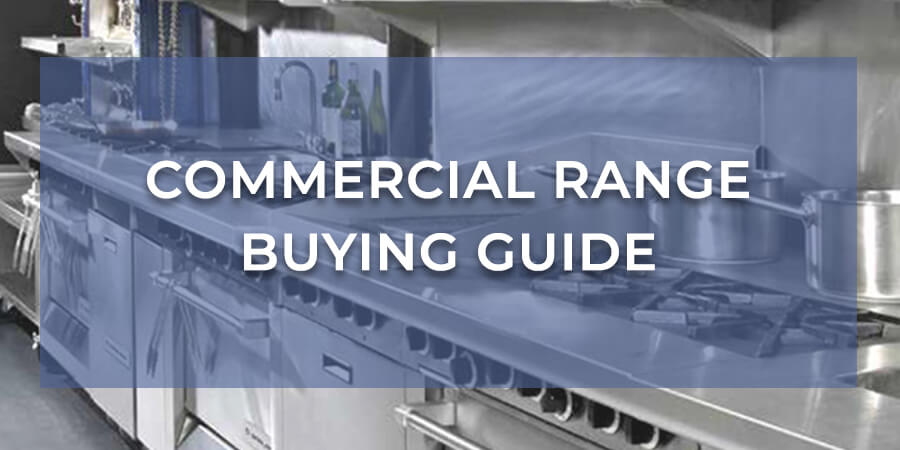
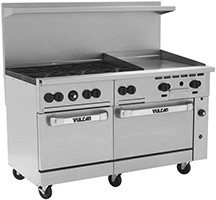
The term "range" is used to describe the combination of a stove and oven. Commercial ranges come in various sizes. They can also come with basic functionality or are fully loaded with features and accessories to run the entire cook load of a commercial kitchen.
Some ranges are gas, some are electric, and some are a combination of both. All range sizes should be available in either propane or natural gas.
You could scour the web for a gas range buying guide or an electric range buying guide and then compare results, but we’ve compiled a cooking range buying guide that is all-encompassing and meant to be much more user-friendly! So whether you are looking into opening a restaurant, helping out a friend, or you're just one of those people looking to learn everything you can when it comes to cooking equipment, you'll find what you need from reading this guide.
1. Start with Stove Top Range Size
Most accessories and features are available for any size range. So, when planning on the addition of a commercial range to your kitchen, the best place to begin planning is by sizing the unit. Choosing the right size stove is paramount, especially in small spaces.
As with most kitchen equipment you need to account for the proper space. (Please see Safety below.) Don’t assume the most common oven sizes or standard sizes will automatically fit your space. Be sure to take measurements and compare them with what’s available.
Commercial stove top range sizes are given metrically by two methods: oven count and width (in inches).
The most common standard gas stove measurements are as follows:
- 1 Oven = 24" - 48" (the most common width is 36") = 2 - 6 burners
- 2 Oven (or 1 Oven + 1 Storage Space) = 48"-60" (the most common width is 60") = 4 - 12 burners
2. Choosing Commercial Kitchen Stoves By Range Burner Output
Once you've got your stove dimensions figured out according to the space you have, you need to consider what you are cooking and select the appropriate output in BTUs (British Thermal Units). Commercial ranges (most often gas-powered) are measured by BTUs per hour. Higher BTU cooking equipment will result in a more costly gas bill, but it will also provide hotter temperatures and a quicker "heat up" time.
Some important thoughts to consider with your commercial range & stove:
- Am I mainly using a wok, frying, simmering, and steaming?
- Am I only cooking for select parts of the operating day?
If you are only frying, steaming, and simmering chances are you don't need rapid "heat up" times. And if you are only cooking for select parts of the day (e.g. lunch for a cafeteria, dinner for a dinner-only restaurant) then you would not need a high output range.
- Am I boiling heavy oils and large pots?
- Am I cooking for a large serving time? (e.g. production cooking, fast food, and quick-serve restaurants that serve all hours of the day)
- Am I cooking a large variety of foods?
If you answered yes to many of these proposed thoughts, then a heavy-duty high output commercial range could work well for you. If you find that you fit into both categories, you may want to consider a range that takes advantage of both gas and electricity.
Range Output Types:
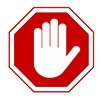
Remember: Always consult your local service technician before purchasing gas-powered oven range equipment. Though the best commercial stoves for restaurants tend to be gas, making sure you have the right equipment for the right gas type is a key safety point. What’s more, the right equipment must be fitted with the proper connections (valves and gas lines). There is no shortcut when it comes to gas.
Restaurant Range Gas Output
You'll find that some gas commercial kitchen ranges are economical or standard grade and will have a standard gas output. These types are best for frying, simmering, and consistency rather than a speedy outcome. Then there are other types such as heavy-duty gas ranges which will have a much higher gas output. These are generally built stronger and are used for all-day venues (that serve breakfast, lunch, and dinner).
Restaurant Range Electric Output
Electric output ranges are both economical and alleviate the need for gas connections. They are also safer. Gas ranges can come with electric capabilities (i.e. convection ovens with gas burners).
It is important to consider that electric ranges give the user two very powerful cooking methods: induction and convection. These methods will be explained in Adding the Necessities (which can be found next).
3. Adding the Necessities
Once you've determined if you have the space needed for a range, you need to consider what you are cooking, the features necessary to cook it, and what quantity is needed. Below is a list of items that can be added to your range.
Induction Ranges

Induction cooking can transform a "cook per order" station into a mass cooking environment. Induction is the cooking technology involving how the elements of a stovetop activate when an induction pot or pan is placed on it. Two things need to be addressed when considering induction.
- A complete set of induction pots and pans must be purchased.
- Induction cooktop ranges are meant for repeated use of the cooktop.
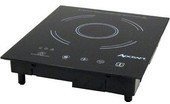
Induction burners will only activate when induction cookware is placed on the range. For most commercial induction ranges, none of your normal pots and pans, etc. will work on an induction burner. It can be quite costly for an induction startup, however, it may pay off in the long run.
Induction burners will deactivate once a piece of induction cookware is removed. While it still usually needs a cool-off period, it is much quicker than conventional stove burners (could be as quick as a matter of seconds).
The stove burners will re-activate as soon as induction cookware is placed back upon the surface. Knobs are not used unless a temperature needs to be adjusted. This allows the cook to rapidly create dishes.
Ranges with Convection Ovens

The technology behind convection cooking is as simple as creating airflow in your commercial restaurant oven. With a conventional oven, gas, or electric, the top rack will consistently be hotter than the bottom while on bake. The person cooking will have to fight to burn the tops of dishes. This is true for both low and high output ranges.
Adding airflow to the oven transforms baking into power cooking. With consistent airflow and evenly spaced cooking elements, the cooking time is lessened - resulting in evenly cooked products that often retain desired elements (such as moisture).
Ranges with Griddles and Broilers
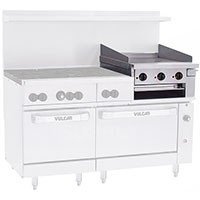
Griddles are often sized, not by what it is cooking, but by how many burners are needed for the stovetop. Griddles can start at 12" and are commonly 24" on larger ranges (such as double ovens). However, it's not often that many ranges on the commercial restaurant market are small in width but sacrifice burners- such as a 36" range with two burners and a griddle. The rule of thumb when considering griddles is to remember that no range is too small.
The same rule applies to broilers. Broilers are most commonly placed directly beneath the griddle and are sized the same. It is important to know that a broiler is overfired (heats from the ceiling) and is used by a chef when cooking a dish that needs to be browned. Therefore, it is easy to fall into the trap of buying a commercial broiler strictly for cooking.
When deciding the necessity of a griddle, process through the following:
- Am I generally cooking breakfast?
- Will I be searing often?
- Will my cut meats require being prepared differently (medium rare, well done, etc.)?
If you answered "yes" to any of these, you may heavily consider using a griddle.
When deciding the necessity of a broiler, consider the following:
- Do I need to brown or melt soup or sandwich toppings?
- Do I need to caramelize sugar substances?
- Do I have qualified servers to extract the dish and simplify the serving process?
If the answer is "yes" to any of these, you need to consider using a broiler.
And lastly, when thinking of how large of a size is needed for either a commercial griddle or commercial broiler:
- Do I need refined control over the product or do I need to concentrate on mass amounts?
Salamanders
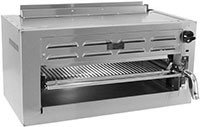
When confined to smaller commercial restaurant spaces, consider the option of using a salamander. Salamanders are the combination of both a griddle and a broiler, which are (in most cases) detachable or a standalone unit. This means the chef can either keep all 10 burners or sacrifice 4 burners for the option to griddle and broil. In the case of a standalone unit, it can be used next to the chef's primary cooking base.
4. Commercial Stove Safety

Commercial Exhaust Hood System and Ventilation
By Law:
Both the NFPA (National Fire Protection Association) and the IMC (International Mechanical Code) have codes surrounding the necessity of an exhaust or ventilation system. There are also many other organizations, some depending on region, that enforce the need for exhaust and ventilation systems. Notably, NFPA 96, found here: https://www.nfpa.org/codes-and-standards/all-codes-and-standards/list-of-codes-and-standards is likely the most quoted standard... but do your research and ask a professional.
What the proper ventilation does:
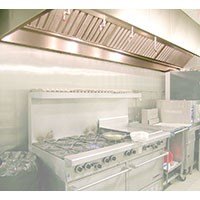
Proper ventilation rids the oven of grease-laden particles often produced by commercial restaurant cooking equipment. It also reduces the risk of inhaling smoke or said grease-laden particles.
A certain amount of space is most definitely needed for the range to breathe. You need a minimum space of six inches surrounding the entire range. This is the required distance for any combustible material. However, it is strongly suggested that no combustible materials exist in the kitchen area.
5. The Professional’s Tips:
If you're on a (monthly) dime, consider that standard restaurant ranges have a lower output. Lower BTUs mean a lower gas bill. Packing it with the right accessories will have you or your chef pleasing lots of customers.
Think about your restaurant kitchen - the way it's laid out, the way the staff moves through it, and how your commercial range will play a part. This may move your range to a different spot in your kitchen than you had originally planned and may require a different size. Lastly, keep in mind that many of the principles listed for safety coincide with how to choose a proper commercial combination wall oven, single wall oven, or double wall oven, not just a gas range or griddle setup.
Comments
Share This!